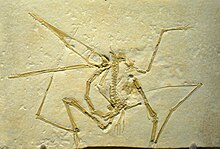Pterodactyloidea
Pterodactyloidea is the suborder of short-tailed pterosaurs. Their fossil record starts in the middle Jurassic. They became extinct in the K/T extinction event at the end of the Cretaceous period. Pterodactylus, Pteranodon and Quetzalcoatlus are in this suborder.
| Pterodactyloids | |
|---|---|

| |
| Pterodactylus antiquus cast, Carnegie Museum of Natural History | |
| Scientific classification | |
| Domain: | Eukaryota |
| Kingdom: | Animalia |
| Phylum: | Chordata |
| Order: | †Pterosauria |
| Clade: | †Caelidracones |
| Suborder: | †Pterodactyloidea Plieninger, 1901 |

In 2014 remains of the earliest pterodactyloid was found in China. It is called Kryptodrakon. Its minimum age was 162.7 million years ago (mya). This is about five million years older than any previously known confirmed specimens.[1]
Recent work shows that the group had more variety at the end of the Cretaceous than was thought earlier. In the early 2010s, several new pterosaur taxa were discovered dating to the late Cretaceous.[2][3] These finds include some small sized pterosaur species.[4][5]
At the end of the Cretaceous period, the Cretaceous–Paleogene extinction event, which made all non-avian and most avian dinosaurs, as well as many other animals, extinct. The pterosaurs seem to have gone extinct in this event.
Classification change
This is the classification of the different divisions of pterodactyloidea:
- Order Pterosauria
- Suborder Pterodactyloidea
- Superfamily Ornithocheiroidea
- Family Istiodactylidae
- Family Ornithocheiridae
- Family Pteranodontidae
- Superfamily Ctenochasmatoidea
- Superfamily Dsungaripteroidea
- Family Dsungaripteridae
- Superfamily Azhdarchoidea
- Family Lonchodectidae
- Family Tapejaridae
- Family Azhdarchidae
- Superfamily Ornithocheiroidea
- Suborder Pterodactyloidea
References change
- ↑ Andres, B.; Clark, J.; Xu, X. (2014). "The earliest pterodactyloid and the origin of the group". Current Biology. 24 (9): 1011–6. doi:10.1016/j.cub.2014.03.030. PMID 24768054. S2CID 18293296.
- ↑ Andres B. & Myers T.S. 2013. Lone Star pterosaurs. Earth and Environmental Science Transactions of the Royal Society of Edinburgh. 103 (3–4): 1.[1]
- ↑ Agnolin, Federico L. & Varricchio, David 2012 (2012). "Systematic reinterpretation of Piksi barbarulna Varricchio, 2002 from the Two Medicine Formation (Upper Cretaceous) of Western USA (Montana) as a pterosaur rather than a bird" (PDF). Geodiversitas. 34 (4): 883–894. doi:10.5252/g2012n4a10. S2CID 56002643. Archived from the original (PDF) on 2013-01-15. Retrieved 2016-09-03.
{{cite journal}}: CS1 maint: multiple names: authors list (link) CS1 maint: numeric names: authors list (link) - ↑ "Does morphology reflect osteohistology-based ontogeny? A case study of late Cretaceous pterosaur jaw symphyses from Hungary reveals hidden taxonomic diversity" (PDF). Paleobiology. 40 (2): 288–321. 2014. doi:10.1666/13030. S2CID 85673254.
{{cite journal}}: Cite uses deprecated parameter|authors=(help) - ↑ Elizabeth Martin-Silverstone; Mark P. Witton; Victoria M. Arbour; Philip J. Currie 2016. A small azhdarchoid pterosaur from the latest Cretaceous, the age of flying giants. Royal Society Open Science. 3 (8): 160333. doi:10.1098/rsos.160333.